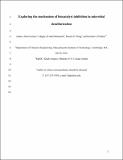| dc.contributor.author | Abin-Fuentes, Andres | |
| dc.contributor.author | Mohamed, Magdy El-Said | |
| dc.contributor.author | Wang, Daniel I. | |
| dc.contributor.author | Prather, Kristala L. Jones | |
| dc.date.accessioned | 2014-12-19T20:28:07Z | |
| dc.date.available | 2014-12-19T20:28:07Z | |
| dc.date.issued | 2013-10 | |
| dc.date.submitted | 2013-08 | |
| dc.identifier.issn | 0099-2240 | |
| dc.identifier.issn | 1098-5336 | |
| dc.identifier.uri | http://hdl.handle.net/1721.1/92419 | |
| dc.description.abstract | Microbial desulfurization, or biodesulfurization (BDS), of fuels is a promising technology because it can desulfurize compounds that are recalcitrant to the current standard technology in the oil industry. One of the obstacles to the commercialization of BDS is the reduction in biocatalyst activity concomitant with the accumulation of the end product, 2-hydroxybiphenyl (HBP), during the process. BDS experiments were performed by incubating Rhodococcus erythropolis IGTS8 resting-cell suspensions with hexadecane at 0.50 (vol/vol) containing 10 mM dibenzothiophene. The resin Dowex Optipore SD-2 was added to the BDS experiments at resin concentrations of 0, 10, or 50 g resin/liter total volume. The HBP concentration within the cytoplasm was estimated to decrease from 1,100 to 260 μM with increasing resin concentration. Despite this finding, productivity did not increase with the resin concentration. This led us to focus on the susceptibility of the desulfurization enzymes toward HBP. Dose-response experiments were performed to identify major inhibitory interactions in the most common BDS pathway, the 4S pathway. HBP was responsible for three of the four major inhibitory interactions identified. The concentrations of HBP that led to a 50% reduction in the enzymes' activities (IC[subscript 50]s) for DszA, DszB, and DszC were measured to be 60 ± 5 μM, 110 ± 10 μM, and 50 ± 5 μM, respectively. The fact that the IC[subscript 50]s for HBP are all significantly lower than the cytoplasmic HBP concentration suggests that the inhibition of the desulfurization enzymes by HBP is responsible for the observed reduction in biocatalyst activity concomitant with HBP generation. | en_US |
| dc.description.sponsorship | National Institutes of Health (U.S.). Biotechnology Training Program | en_US |
| dc.language.iso | en_US | |
| dc.publisher | American Society for Microbiology | en_US |
| dc.relation.isversionof | http://dx.doi.org/10.1128/aem.02696-13 | en_US |
| dc.rights | Creative Commons Attribution-Noncommercial-Share Alike | en_US |
| dc.rights.uri | http://creativecommons.org/licenses/by-nc-sa/4.0/ | en_US |
| dc.source | Prof. Prather via Erja Kajosalo | en_US |
| dc.title | Exploring the Mechanism of Biocatalyst Inhibition in Microbial Desulfurization | en_US |
| dc.type | Article | en_US |
| dc.identifier.citation | Abin-Fuentes, A., M. E.-S. Mohamed, D. I. C. Wang, and K. L. J. Prather. “Exploring the Mechanism of Biocatalyst Inhibition in Microbial Desulfurization.” Applied and Environmental Microbiology 79, no. 24 (October 4, 2013): 7807–7817. | en_US |
| dc.contributor.department | Massachusetts Institute of Technology. Department of Chemical Engineering | en_US |
| dc.contributor.approver | Prather, Kristala L. Jones | en_US |
| dc.contributor.mitauthor | Abin-Fuentes, Andres | en_US |
| dc.contributor.mitauthor | Wang, Daniel I. | en_US |
| dc.contributor.mitauthor | Prather, Kristala L. Jones | en_US |
| dc.relation.journal | Applied and Environmental Microbiology | en_US |
| dc.eprint.version | Author's final manuscript | en_US |
| dc.type.uri | http://purl.org/eprint/type/JournalArticle | en_US |
| eprint.status | http://purl.org/eprint/status/PeerReviewed | en_US |
| dspace.orderedauthors | Abin-Fuentes, A.; Mohamed, M. E.-S.; Wang, D. I. C.; Prather, K. L. J. | en_US |
| dc.identifier.orcid | https://orcid.org/0000-0002-2046-2726 | |
| dc.identifier.orcid | https://orcid.org/0000-0003-0437-3157 | |
| mit.license | OPEN_ACCESS_POLICY | en_US |
| mit.metadata.status | Complete | |
